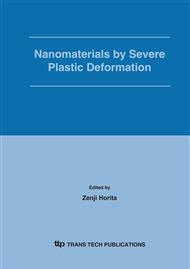[1]
V.M. Segal, V.I. Reznikov, A.E. Drobysgevsky and V.I. Kopylov: Russian Metallurgy (Metally) Vol. 1 (1981), p.99.
Google Scholar
[2]
R.V. Valiev, N.A. Krasilnikov and N.K. Tsenev: Mater. Sci. Eng. A Vol. A137 (1991), p.35.
Google Scholar
[3]
Y. Saito, N. Tsuji, H. Utsunomiya, T. Sakai and R.G. Hong: Scripta Mater. Vol. 39 (1998), p.1221.
Google Scholar
[4]
Y. Saito, H. Utsunomiya, N. Tsuji and T. Sakai: Acta Mater. Vol. 47 (1999), p.579.
Google Scholar
[5]
M. Furukawa, Z. Horita, M. Nemoto, R.Z. Valiev and T.G. Langdon: Acta Mater. Vol. 44 (1996), p.4619.
Google Scholar
[6]
T.G. Langdon, M. Furukawa, Z. Horita and M. Nemoto: JOM Vol. 50-6 (1998), p.41.
Google Scholar
[7]
H. Hasegawa, S. Komura, A. Utsunomiya, Z. Horita, M. Furukawa, M. Nemoto and T.G. Langdon: Mater. Sci. Eng. A Vol. A265 (1999), p.188.
Google Scholar
[8]
Z. Horita, T. Fujinami, M. Nemoto and T.G. Langdon: J. Mater. Process. Technol. Vol. 117 (2001), p.288.
Google Scholar
[9]
N. Tsuji, Y. Saito, H. Utsunomiya and S. Tanigawa: Scripta Mater. Vol. 40 (1999), p.795.
Google Scholar
[10]
S. Komura, Z. Horita, M. Furukawa, M. Nemoto and T.G. Langdon: Metall. Mater. Trans. A Vol. 32A (2001), p.707.
Google Scholar
[11]
R. Ito, C. Shiga, Y. Kawaguchi, T. Nakamura, K. Hiraoka, T. Hayashi and S. Torizuka: ISIJ Int. (suppl) Vol. 40 (2000), p. S29.
DOI: 10.2355/isijinternational.40.suppl_s29
Google Scholar
[12]
Y.S. Sato, M. Urata, H. Kokawa, K. Ikeda and M. Enomoto: Scripta Mater. Vol. 45 (2001), p.109.
Google Scholar
[13]
C.J. Dawes and W.M. Thomas: Weld. J. Vol. 75-3 (1996), p.41.
Google Scholar
[14]
M.W. Mahoney, C.G. Rhodes, J.G. Flintoff, R.A. Spurling and W.H. Bampton: Metall. Mater. Trans. A Vol. 29A (1998), p. (1955).
Google Scholar
[15]
Y.S. Sato, H. Kokawa, M. Enomoto and S. Jogan: Metall. Mater. Trans. A Vol. 30A (1999), p.2429.
Google Scholar
[16]
K.V. Jata, K.K. Sankaran and J.J. Rushau: Metall. Mater. Trans. A Vol. 31A (2000), p.2181.
Google Scholar
[17]
Y.S. Sato, Y. Sugiura, Y. Shoji, S.H.C. Park, H. Kokawa and K. Ikeda: Mater. Sci. Eng. A Vol. A369 (2004), p.138.
Google Scholar
[18]
K.A.A. Hassan, A.F. Norman, D.A. Price and P.B. Prangnell: Acta Mater. Vol. 51 (2003), p. (1923).
Google Scholar
[19]
S.H.C. Park, Y.S. Sato and H. Kokawa: Metall. Mater. Trans. A Vol. 34A (2003), p.987.
Google Scholar
[20]
J.Q. Su, T.W. Nelson and C.J. Sterling: J. Mater. Res. Vol. 18 (2003), p.1757.
Google Scholar
[21]
S.H.C. Park, Y.S. Sato, H. Kokawa, K. Okamoto, S. Hirano and M. Inagaki: Scripta Mater. Vol. 49 (2003), p.1175.
Google Scholar
[22]
Y.S. Sato, T.W. Nelson and C.J. Sterling: Acta Mater. Vol. 53 (2005), p.637.
Google Scholar
[23]
Y.S. Sato, M. Urata, H. Kokawa and K. Ikeda: Scripta Mater. Vol. 47 (2002), p.869.
Google Scholar
[24]
Y.S. Sato, M. Urata, H. Kokawa and K. Ikeda: Mater. Sci. Eng. A Vol. A354 (2003), p.298.
Google Scholar
[25]
Y.S. Sato, M. Urata, H. Kokawa and K. Ikeda: Mater. Sci. Forum Vol. 426-432 (2003), p.2947.
Google Scholar
[26]
Y.S. Sato, Y. Kurihara, S.H.C. Park, H. Kokawa and N. Tsuji: Scripta Mater. Vol. 50 (2004), p.57.
Google Scholar
[27]
Y. Ito, N. Tsuji, Y. Saito, H. Utsunomiya and T. Sakai: J. Jpn Inst. Met. Vol. 64 (2000), p.429.
Google Scholar
[28]
N. Tsuji, Y. Ito, H. Nakashima, F. Yoshida and Y. Minamino: Mater. Sci. Forum Vol. 396-402 (2002), p.423.
Google Scholar
[29]
X. Huang, N. Tsuji, N. Hansen and Y. Minamino: Mater. Sci. Eng. A, Vol. A340 (2003), p.265.
Google Scholar
[30]
R. Ueji, X. Huang, N. Hansen, N. Tsuji and Y. Minamino: Mater. Sci. Forum Vol. 426-432 (2003), p.405.
Google Scholar
[31]
K.V. Jata and S.L. Semiatin: Scripta Mater. Vol. 43 (2000), p.743.
Google Scholar
[32]
D.P. Field, T.W. Nelson, Y. Hovanski and K.V. Jata: Metall. Mater. Trans. A Vol. 32A (2001), p.2869.
Google Scholar
[33]
Y.S. Sato, H. Kokawa, K. Ikeda, M. Enomoto, S. Jogan and T. Hashimoto: Metall. Mater. Trans. A Vol. 32A (2001), p.941.
Google Scholar
[34]
Y.S. Sato and H. Kokawa: Metall. Mater. Trans. A Vol. 32A (2001), p.3023.
Google Scholar
[35]
Y.S. Sato, M. Urata and H. Kokawa: Metall. Mater. Trans. A Vol. 33A (2002), p.625.
Google Scholar
[36]
B. Heinz and B. Skrotzki: Metall. Mater. Trans. B Vol. 33A (2002), p.489.
Google Scholar
[37]
J.Q. Su, T.W. Nelson, R. Mishra and M. Mahoney: Acta Mater. Vol. 51 (2003), p.713.
Google Scholar
[38]
Y.S. Sato, S.H.C. Park and H. Kokawa: Metall. Mater. Trans. A Vol. 32A (2001), p.3033.
Google Scholar


